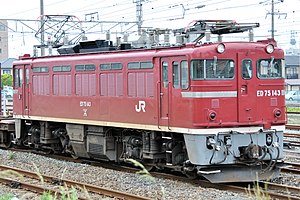JNR Class ED75

JR Freight refurbished ED75 143, June 2010
|
|||||||||||||||||||||||
|
|||||||||||||||||||||||
|
|||||||||||||||||||||||
|
|||||||||||||||||||||||
|
|||||||||||||||||||||||
| Type and origin | |
|---|---|
| Power type | Electric |
| Builder | Hitachi, Mitsubishi, Toshiba |
| Build date | 1963–1976 |
| Total produced | 302 |
| Specifications | |
|---|---|
| UIC class | Bo-Bo |
| Gauge | 1,067 mm (3 ft 6 in) |
| Bogies | DT129 |
| Wheel diameter | 1,120 mm (3 ft 8 in) |
| Length | 14,300 mm (46 ft 11 in) |
| Width | 2,800 mm (9 ft 2 in) |
| Loco weight | 67.2 t |
| Electric system(s) | 20 kV AC |
| Current collection | Overhead catenary |
| Traction motors | MT52 x 4 |
| Performance figures | |
|---|---|
| Maximum speed | 100 km/h (60 mph) |
| Power output | 1,900 kW |
| Career | |
|---|---|
| Operators | |
| Number in class | 5 (as of 1 April 2016[update]) |
| Delivered | 1963 |
| Preserved | 3 |
| Disposition | Still in service |
The Class ED75 (ED75形?) is a Bo-Bo wheel arrangement AC electric locomotive type operated on passenger and freight services in Japan since 1963. A total of 302 locomotives were built by Hitachi, Mitsubishi, and Toshiba between 1963 and 1976. As of 1 April 2016[update], just five locomotives remained in service, all operated by JR East.
This was the original type. Two prototypes, ED75 1 and 2, were delivered in 1963, built by Hitachi and Mitsubishi. Following test running, a further 158 locomotives were built from 1964 by Hitachi, Mitsubishi, and Toshiba. Locomotive numbers 50 to 100 were equipped for cold regions, and were fitted with icicle cutters above the driving cab windows. As of 1 April 2016[update], no Class ED75-0 locomotives remained in service.
11 Class ED75-300 locomotives were built from 1965 to 1968 by Hitachi and Mitsubishi for use in Kyushu, numbered ED75 301 to ED75 311. These locomotives used a 20 kV AC 60 Hz power supply.
ED75 304 in the early 1980s
One Class ED75-500 locomotive, number ED75 501 was built experimentally for use on the recently electrified Hakodate Main Line between Otaru and Asahi in Hokkaido. No further locomotives in this sub-class were built, as Class ED76-500 locomotives were instead chosen for this route.
ED75-501, preserved at the Otaru City Museum, August 2009
91 Class ED75-700 locomotives were built from 1971 to 1976 by Hitachi, Mitsubishi, and Toshiba, for use on the Ou Main Line and Uetsu Main Line, numbered ED75 701 to ED75 791. These locomotives used a 20 kV AC 50 Hz power supply. These locomotives differed from earlier examples in having PS103 cross-arm type pantographs. 34 members of this subclass were converted to become Class ED79 locomotives in 1988 for use on services through the undersea Seikan Tunnel between Honshu and Hokkaido.
...
Wikipedia
